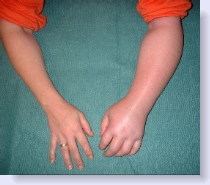The following four criteria are used to diagnose CRPS-
- An initiating noxious event is responsible for the patient’s immobilization.
- The patient has continuing pain, allodynia, or hyperalgesia that is disproportionate to any inciting event.
- Edema, changes in skin blood flow, or abnormal sudomotor activity in the region of the pain.
- The syndrome is excluded by the existence of a condition that would otherwise account for the degree of pain and dysfunction.

The cause of the syndrome may not be evident. In CRPS type I (also called as reflex sympathetic dystrophy), minor injuries or fractures of a limb precede the onset of symptoms. CRPS type II (also called causalgia) develops after an injury to a major peripheral nerve.
Management
Treatment should be started as early as possible and most importantly directed toward restoration of full function of the extremity.
Pharmacotherapy:
NSAIDs, Opioids, antidepressants(amitriptyline), and anticonvulsants (gabapentin, pregabalin), are used to treat pain that originates from a damaged nerve (neuropathic pain). Corticosteroids, such as prednisone, may reduce inflammation, useful during acute CRPS. Your doctor may suggest bone-loss medications, such as alendronate and calcitonin. Other medications like Sodium channel blockers ( Lignocaine IV), NMDA receptor blockers (Ketamine, flupirtine, dextromethorphan) are also used. Topical analgesics may reduce hypersensitivities, such as lidocaine, capsaicin or a combination of ketamine, clonidine, and amitriptyline.
Treatment Options Or Interventions
- Sympathetic Neurolysis like Stellate Gangli block, Lumbar Sympathetic Block, etc.
- Spinal Cord Stimulator
- Lignocaine / Ketamine Infusion
- Sympathetic ganglion blocks
- Physical therapy, psychological therapy: Gentle, guided exercising of the affected limbs may improve range of motion and strength. Careful contralateral physical therapy should be the acute treatment of choice. Applying heat and cold also helps
- Transcutaneous electrical nerve stimulation (TENS). Chronic pain is sometimes eased by applying electrical impulses to nerve endings.
- Biofeedback. In some cases, learning biofeedback techniques may help. In biofeedback, you learn to become more aware of your body so that you can relax your body and relieve pain.
- Spinal cord stimulation & intrathecal clonidine is considered in refractory cases.



